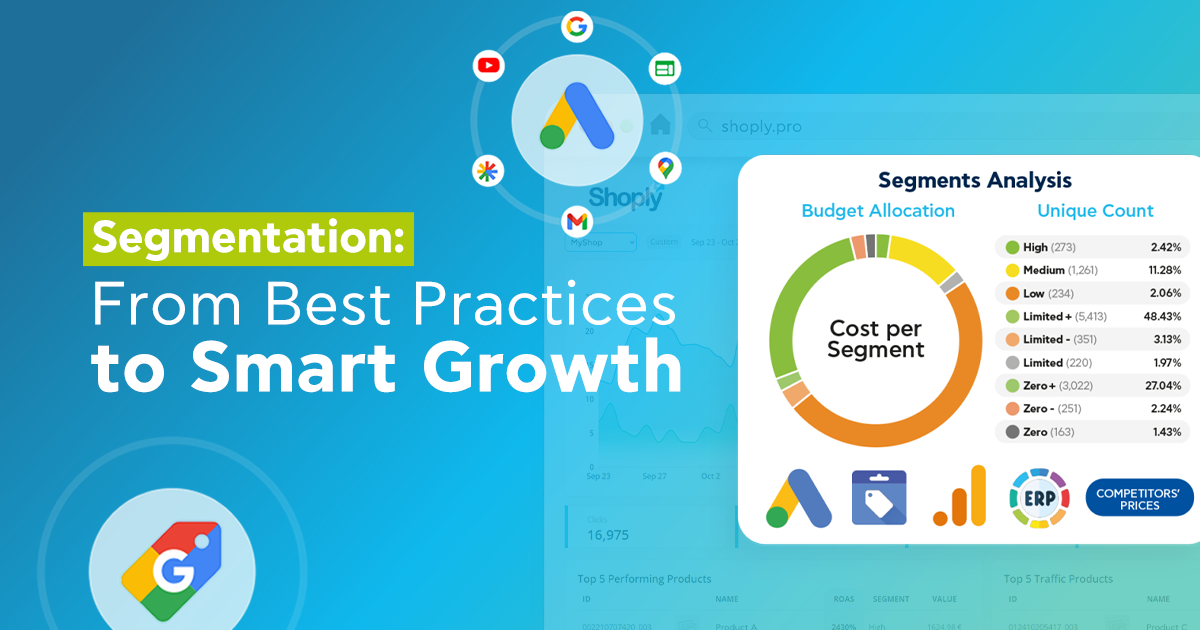Running Shopping Ads or Performance Max campaigns without segmentation is like throwing your entire catalog into a single basket and letting Google decide which products deserve the spotlight. Sure, automation can deliver results, but without structure, budgets often get funneled into the wrong places. High-potential products might stay hidden, while low-converting ones eat up ad spend.
Segmentation is where strategy meets efficiency. By breaking down your product catalog into smart, meaningful product groups, you gain control over how traffic and budget are distributed. Instead of hoping Google’s algorithm will figure it out, you’re actively steering performance toward your business goals, whether that’s boosting conversions, scaling revenue, or protecting profit margins.
Popular Segmentation Strategies
There isn’t a single “best” way to segment; it depends on your goals, catalog size, and data availability. Still, some tried-and-true approaches stand out in eCommerce performance marketing:
1. Consolidated Campaigns
For very small catalogs or accounts with limited conversions, running everything in a single campaign can sometimes be the smarter play as it gathers data in one place, making bidding more reliable. The trade-off is obvious, though: you sacrifice control, because all products are treated equally.
2. Highlighting Top Sellers
One of the most intuitive methods is to isolate your proven winners, the products you know convert well or expect to perform strongly during seasonal peaks. Assigning them a campaign or ad group guarantees that they will get the majority of the budget and impressions. The upside is predictable performance, but it relies heavily on historic data and might miss shifts in market dynamics.
3. Margin-Driven Segmentation
Not all revenue is created equal. Segmenting based on profit margins allows you to push the items that bring the highest returns, ensuring that every advertising dollar ties back to actual business growth. The challenge? You need accurate cost data, and maintaining that across hundreds or thousands of SKUs can be messy.
4. Category or Brand Breakdowns
Sometimes the simplest route is the most effective. Splitting campaigns by product category or brand helps align bidding with natural purchase behavior. A premium footwear line won’t behave the same way as budget sneakers, and a high-frequency consumable won’t scale like a one-off luxury item. Category-level segmentation makes sure these differences are reflected in your strategy.
5. Performance-Based Buckets
This is where segmentation gets tactical. By grouping products according to their past performance: top converters, average performers, underperformers, you can apply different bidding and budget strategies to each. It’s a flexible system that evolves with your data, but managing it manually can quickly become a full-time job, especially with large catalogs.

The Shoply Way: Smarter Segmentation Without the Heavy Lifting
All the methods we’ve discussed so far work, but let’s be honest, they’re also resource-heavy. Manually creating and maintaining segmentation rules eats up time, increases the risk of human error, and can delay critical optimizations. Every hour spent adjusting campaigns by hand is not only a labor cost, but also a lost opportunity if changes aren’t applied fast enough.
That’s where Shoply steps in. Instead of relying on endless spreadsheets and manual rules, Shoply uses predictive analytics to streamline the entire segmentation process. By combining statistical models with real-time performance data, it takes the guesswork out of campaign management and ensures your product groups are always optimized.
Our approach pulls data from multiple sources — Google Ads, Merchant Center, GA4 — and, when available, even your ERP system that connects offline and online sales. This 360° view allows Shoply to build smarter, more dynamic segments that actually reflect your business reality, not just surface-level campaign metrics.
And here’s the kicker: segmentation isn’t just about clicks and conversions. With Shoply, you can factor in profitability. By layering in product-level margin data, the platform ensures your campaigns are aligned with true business outcomes — pushing not just revenue, but profitable growth.
The result?
- Less wasted budget on products that don’t convert.
- Smarter allocation of spend where it actually matters.
- Reduced reliance on manual labor and the errors that come with it.
- Faster, more responsive campaign adjustments that keep you ahead of the competition.
In short, Shoply makes segmentation scalable. Instead of segmenting “because best practice says so,” you’re segmenting with precision, powered by data and predictive models designed to maximize both performance and profitability.
Future-Proofing Your Shopping & PMax Campaigns
Segmentation isn’t just a technical trick, it’s the foundation of smarter eCommerce advertising. While traditional approaches like segmenting by best sellers, margins, or categories have their place, they all share the same challenge: they demand constant manual effort.
With Shoply, segmentation evolves from a time-consuming chore into a data-driven growth engine. Shoply gives advertisers the control they need without the extra workload.
For e-shops and performance marketers looking to scale Google Shopping Ads and PMax campaigns, that’s not just optimization, it’s future-proofing your growth.



